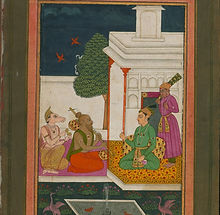Dhatu
The structural components of a musical composition are referred to as Dhātu. Typically, a composition consists of four or five Dhātus, although lighter compositions may have only two.
The five paragraphs or Dhātus are as follows:
1. Udgrāha: The opening paragraph or first stanza, known as Udgrāha Dhātu.
2. Melāpaka: The paragraph connecting the opening with the Dhruva.
3. Dhruva: The paragraph or a portion thereof repeated after the musician's improvisation. According to classical texts, Melāpaka and Ābhoga paragraphs can be omitted, but never the Dhruva Dhātu.
4. Ābhoga: The last paragraph or stanza containing the author's name.
5. Antara or Antarā: The paragraph between the Dhruva and Ābhoga, resembling the Tuka Aṁśa, Kali, or Caraṇa used today.
While the Dhruva is akin to the Sthāyī Tuka, Antara and Ābhoga are similar to their contemporary forms. The Melāpaka Dhātu shares similarities with the Sañcārī Tuka, combining Udgrāha and Dhruva, and influencing Sthāyī and Antara Tuka by merging both.
Though Udgrāha, mentioned in classical texts, is now obsolete, parallels can be drawn with what is perceived as a prelude, akin to the introduction of Rāgas known as Aucār Ālāpa.
In modern compositions, an additional paragraph is often included within a Gat or composition, known as Māṁjhā or Māṁjā. Formally part of the Sthāyī, it is introduced between the initial and final paragraphs.
INDIAN CLASSICAL MUSIC LESSONS AND ONLINE COURSES
IN MODAL MUSIC, IMPROVISATION AND COMPOSITION
LEARN THE MAIN TECHNIQUES OF INDIAN MUSIC WITH A SIMPLE AND PERSONALIZED METHOD!
My online music lessons are the perfect way to learn to sing, or improve the vocal techniques already acquired, or to start playing your favorite instrument or progress in your musical path through an alternative teaching method to Western teaching.
The goal of my Indian classical music courses is to teach you the basics of this wonderful art form. You will learn about the various Ragas, or modal scales, the Talas or rhythmic cycles, and the vocal and instrumental techniques used for improvisation in Indian classical music.
What makes my approach to teaching indian classical music so distinctive?
My teaching system is obviously unique and different from others and I think that learning music following the traditional Indian approach is the most effective method regardless of genre: pop, jazz, world fusion, electronic, whatever musical style you if you are interested, I guarantee that thanks to the Indian perspective, you will have an edge over all the other musicians.
What will you learn?
During my lessons I use a variety of techniques and exercises to learn to improvise and compose. What you will learn in my Indian classical music courses will be based on the concepts of modal scale and rhythmic cycle, i.e. Raga and Tala. You will also learn vocal and instrumental techniques which, although based on Indian musical theory, also find application in the Western musical system.
Will the course suit you?
My courses are aimed to all musicians of all levels, beginners, intermediate and advanced, offering different study materials and techniques from the usual Western standards. All those who want to learn to play Indian classical music are welcome and no previous knowledge or experience is necessary to get started.
I can not wait to get to know you!
Contact me now! The first lesson is FREE!











%2018th-19th%20centuries%20b.jpg)




